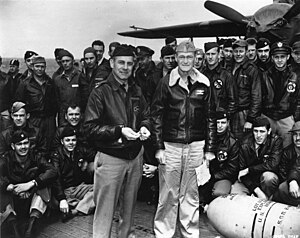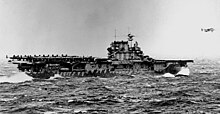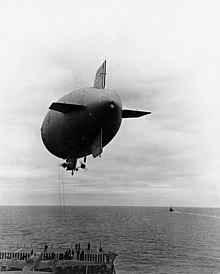Doolittle Raid
| date | April 18, 1942 |
|---|---|
| place | Tokyo , Japan |
| output | Propaganda victory for the Americans |
| Parties to the conflict | |
|---|---|
|
United States |
Japan |
| Commander | |
|
- |
|
| Troop strength | |
| 16 B-25B Mitchell (with a total of 80 crew members) | - |
| losses | |
|
3 dead (2 drowned, 1 fell from a cliff) |
approx. 50 dead |
Doolittle Raid is the name of a surprise attack by the US Army on April 18, 1942 on Tokyo . This WWII operation during the Pacific War was named for its military chief, Lieutenant Colonel James H. Doolittle . It was the first attack on the Japanese home islands in this war and was mainly used for psychological warfare .
preparation
The military strike - as the first "answer" to Pearl Harbor - against the main Japanese islands in a relatively early phase of the Pacific War was based on a study which, as a result, considered the launch of twin-engined bombers from an aircraft carrier towards Japan as possible. Admiral Ernest J. King and US Air Force General Henry H. Arnold were immediately enthusiastic about this result. Arnold selected the tech-savvy James H. Doolittle as operations manager, who put together a suitable team for this mission.
The modern and light North American B-25 Mitchell were chosen as bombers . Tests had shown they could take off from an aircraft carrier with enough bombs and enough fuel on board. After the bombing of Tokyo, the planes should continue to fly to China and land there.
The heavy machine guns were removed from the aircraft to make room for additional tanks. In order to irritate enemy hunters , wooden dummies were installed in the stern , which looked like real machine guns from a distance. Each machine was loaded with four 500 pound (227 kg) bombs .
The volunteers recruited by Doolittle underwent tough training and knew they would be going into a very dangerous mission.
execution
The aircraft carrier USS Hornet , which had only recently been commissioned, was ordered to the Pacific under the command of Captain Marc A. Mitscher . The company was so secret that Mitscher wasn't informed of the plan until the 16 planes boarded. Due to space problems (the planes had no retractable wings), the Americans put them in the order in which they were supposed to take off, crowded together on the flight deck of the USS Hornet. The machines could not be accommodated below deck, but had to be serviced on deck during the entire operation.
On April 2, 1942, the Hornet set course for Japan. On April 13, the USS Enterprise joined the Hornet in order to take over the self-protection of the unit, since the fighters of the Hornet could not perform this task because of the blocked flight deck.
On April 11th, the L-8 airship took off from San Francisco. It supplied navigation domes and spare parts that had not been installed before departure.
The launch was planned for April 18 at a distance of 400 nautical miles (approx. 740 km) from the mainland . However, as radar echoes from Japanese patrol boats were detected earlier than expected , the start was brought forward. When the planes took off around 8 a.m. local time, the Hornet was still 600 nautical miles (approx. 1100 km) away from Japan.
Most of the five-crew B-25B bombed military and industrial facilities in Tokyo or Yokohama . Some hit plants in Nagoya City ; From a military point of view, however, the damage caused was not very high. There were around 50 dead and 400 injured on the Japanese side.
The Japanese air defense and air force were so surprised that they practically did not make an appearance for the small B-25B fleet. All machines were able to leave Japan undamaged for China. But one machine had so little fuel left that it had to set course for the Soviet Union , which at that time was still neutral with respect to Japan . After they fell north of Vladivostok , the team was interned by the Soviets and was only able to return to the USA via Iran after more than a year .
The other machines came to the Chinese coast in the dark. Four planes crashed due to lack of fuel directly in front of or on the coast. Since the other eleven machines ran out of fuel after a fifteen-hour flight, the crews left them with their parachutes over the Japanese-occupied hinterland. Most of the crew were hidden from the Chinese people, but eight of them were captured by the Japanese.
consequences
In response to the unexpected attack, the Japanese leadership illegally executed three of the prisoners in Shanghai . Another prisoner of war died in captivity. Japan also developed the balloon bomb project, which, however, played only a very minor role in the military conflict.
As an additional measure against further American attacks, the Japanese high command decided to extend the chain of outposts in the Pacific. This decision led to the Battle of Midway on June 4, 1942 .
Due to the help that the American pilots received from the Chinese civilian population, the Japanese army launched the Zhejiang-Jiangxi offensive in May 1942 , in the course of which around 250,000 Chinese civilians were killed. Many of the victims died from anthrax spread by Unit 731 in the area.
On February 27, 1946, an American court martial in Shanghai began proceedings against the Japanese who were ostensibly responsible for the execution of the aviators. It was expected that this trial would set a precedent for the upcoming trial against the major war criminals before the International Military Tribunal for the Far East , which is why its chief prosecutor, Joseph Berry Keenan, also came for observation.
Files of the Investigative Records Repository (IRR) that have only been accessible since 2002 show that the order for the execution of the Doolittle Airmen was actually carried out by Prince Higashikuni Naruhiko - as the commander of the Japanese Home Guard. The Americans also determined that he was planning to replace the Tennō Hirohito with the underage Akihito and take over the imperial reign himself.
On March 29, 2015, Robert L. Hite , the last survivor of the eight US prisoners of war, died at the age of 95. Two months earlier, his comrade, bomber pilot Edward J. Saylor , had died at the age of 94.
literature
- Stan Cohen (Ed.): Destination Tokyo. A pictorial history of Doolittle's Tokyo Raid, April 8, 1942. Missoula, Mt. 1992, ISBN 0-929521-52-8 .
- Carroll V. Glines: The Doolittle Raid. America's first strike against Japan. Orion Books, New York 1988, ISBN 0-517-56748-2 .
- Charles R. Greening: Not as briefed. From the Doolittle Raid to a German Stalag. WSU Press, Washington, DC 2001, ISBN 0-87422-239-7 .
- James M. Merrill: Target Tokyo. The Halsey-Doolittle Raid. Rand McNally , Chicago, Ill. 1964.
- Craig Nelson: The first heroes. The extraordinary story of the Doolittle Raid. Corgi Books, London, 2002, ISBN 0-552-77171-6 .
- Duane P. Schultz: The Doolittle Raid. St. Martins Press, New York 1988, ISBN 0-312-02195-X .
Video documentation
- One Hour Over Tokyo: Doolittle Raid , A&E Home Video, 2002 ( NTSC format only )
Film adaptations
- Destination Tokyo (Original: Destination Tokyo ), 1943, directed by Delmer Daves , actors: Cary Grant , John Garfield a . a.
- Thirty Seconds Over Tokyo (Original: Thirty Seconds Over Tokyo ), 1944, directed by Mervyn LeRoy Cast: Van Johnson , Spencer Tracy , u. a.
- In the film Pearl Harbor , the Doolittle Raid is treated as an American reaction to the Japanese attack.
- The film Battle for Midway also starts with the Doolittle Raid .
Web links
- US Navy page about the Doolittle Raid. (English)
Individual evidence
- ↑ 80 Brave Men: The Doolittle Tokyo Raiders Roster. (accessed April 2, 2012)
- ↑ cf. Records of the Army Staff: The Investigative Records Repository (IRR). released under the provisions of the US Japanese Imperial Government Disclosure Act of 2000
- ↑ Sam Roberts: Robert Hite, 95, Survivor of Doolittle Raid and Japanese Imprisonment, Dies. In: The New York Times of March 30, 2015 (accessed March 31, 2015).
- ^ Edward Saylor dies at 94; Doolittle Raider who flew risky WWII raid. In: Los Angeles Times, February 2, 2015 (accessed April 2, 2015).




